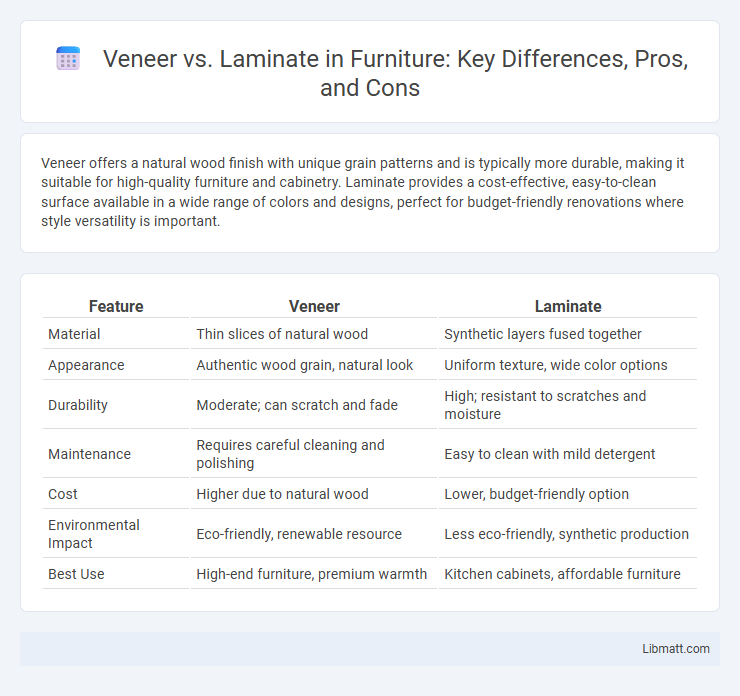Veneer offers a natural wood finish with unique grain patterns and is typically more durable, making it suitable for high-quality furniture and cabinetry. Laminate provides a cost-effective, easy-to-clean surface available in a wide range of colors and designs, perfect for budget-friendly renovations where style versatility is important.
Table of Comparison
| Feature | Veneer | Laminate |
|---|---|---|
| Material | Thin slices of natural wood | Synthetic layers fused together |
| Appearance | Authentic wood grain, natural look | Uniform texture, wide color options |
| Durability | Moderate; can scratch and fade | High; resistant to scratches and moisture |
| Maintenance | Requires careful cleaning and polishing | Easy to clean with mild detergent |
| Cost | Higher due to natural wood | Lower, budget-friendly option |
| Environmental Impact | Eco-friendly, renewable resource | Less eco-friendly, synthetic production |
| Best Use | High-end furniture, premium warmth | Kitchen cabinets, affordable furniture |
Introduction to Veneer and Laminate
Veneer consists of thin layers of natural wood sliced from logs, offering authentic texture and unique grain patterns that enhance furniture and cabinetry. Laminate is a synthetic material made by fusing multiple layers of paper or fabric with resin, providing a durable, cost-effective surface resistant to scratches and moisture. Understanding the differences helps you choose the ideal finish for your interior design or renovation project.
What is Veneer?
Veneer is a thin layer of natural wood sliced from high-quality timber, commonly used to cover surfaces and enhance furniture aesthetics while maintaining the genuine wood texture. Unlike laminate, which is synthetic and printed to mimic wood grain, veneer retains the unique patterns, grains, and natural characteristics of the original wood. It provides an authentic wood finish that can be sanded and refinished, making it a preferred choice for luxury interiors and cabinetry.
What is Laminate?
Laminate is a synthetic flooring material made by fusing multiple layers of paper or fabric with resin, resulting in a durable and cost-effective surface that mimics the appearance of wood or stone. Unlike veneer, which uses a thin slice of real wood, laminate offers enhanced scratch resistance and moisture protection, making it ideal for high-traffic areas and kitchens. Your choice of laminate provides easy maintenance and long-lasting durability without the higher price tag associated with natural wood veneers.
Key Differences Between Veneer and Laminate
Veneer consists of thin slices of natural wood applied to furniture surfaces, offering authentic wood grain patterns and a more luxurious appearance, while laminate is a synthetic, durable surface made from layers of paper and resin with printed designs that mimic wood or other materials. Veneers tend to be more expensive and require careful maintenance to prevent damage, whereas laminates are more affordable, resistant to scratches, moisture, and heat, making them ideal for high-traffic or budget-conscious settings. Choosing between veneer and laminate depends on desired aesthetics, durability needs, and budget constraints.
Appearance and Aesthetic Comparison
Veneers offer a natural wood grain appearance with unique textures and color variations, enhancing the authenticity of furniture and cabinetry. Laminates provide a wider range of colors, patterns, and finishes, including wood grain, stone, and solid hues, allowing for versatile design options. Your choice depends on whether you prefer the genuine look and warmth of veneer or the customizable and durable surface of laminate.
Durability and Maintenance
Veneer offers superior durability compared to laminate due to its natural wood composition, resisting scratches and dents more effectively over time. Maintenance for veneer involves gentle cleaning with wood-specific products to preserve its finish, while laminate requires regular wiping with mild detergents to prevent surface damage and peeling. Your choice depends on balancing the authentic wood feel of veneer with the easier upkeep and moisture resistance of laminate.
Cost Analysis: Veneer vs Laminate
Veneers typically cost between $4 and $12 per square foot, reflecting their natural wood origins and craftsmanship, while laminates range from $1 to $5 per square foot, offering a budget-friendly alternative with synthetic materials. Installation expenses for veneers can be higher due to the need for skilled labor to handle delicate wood slices, whereas laminates generally require less specialized installation, reducing overall costs. Considering durability, veneers may require more maintenance, potentially increasing long-term expenses compared to the more resilient, low-maintenance laminate surfaces.
Environmental Impact
Veneer is made from thin slices of real wood, making it a more sustainable choice due to its biodegradability and lower carbon footprint compared to laminate, which is composed of synthetic materials and resins that can release harmful chemicals during production and disposal. Your preference for eco-friendly options can lean towards veneer, as it utilizes natural wood and supports responsible forestry practices. Laminate's production process often involves plastic-based components, contributing to long-term environmental pollution and reduced recyclability.
Applications and Best Use Cases
Veneer is ideal for high-end furniture, cabinetry, and architectural millwork where natural wood appearance and texture are desired, offering durability and a premium finish. Laminate excels in commercial environments, kitchens, and office furniture due to its resistance to scratches, moisture, and heat, making it cost-effective and low-maintenance. Choosing veneer or laminate depends on balancing aesthetic appeal with practical performance requirements in specific applications.
Which is Better: Veneer or Laminate?
Veneer offers a natural wood appearance with unique grain patterns and higher durability, making it ideal for high-end furniture and cabinetry, while laminate provides cost-effective, versatile, and easy-to-maintain surfaces with a wide range of colors and textures. Laminate's resistance to scratches, moisture, and heat suits busy environments, but veneer's authentic look and ability to be refinished contribute to its long-term value. Choosing between veneer and laminate depends on budget constraints, aesthetic preferences, and the intended use of the surface.
Veneer vs Laminate Infographic

 libmatt.com
libmatt.com